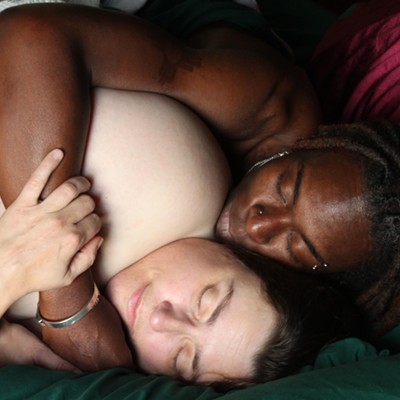Well, they weren't chosen with an eye toward inclusion or political correctness, that's for sure. If you entered the museum through its original main entrances on Forbes Avenue, you had to do so beneath the unrelenting gaze of four dead white European males.
Of course, when the museum was being built at the turn of the century, those were the only people who really counted. Though Andrew Carnegie intended his museum to display all the forms of creative expression -- art and science, literature and performance -- like most people of his day he had a fairly narrow sense of who the key contributors in those fields were. And however much it strived to preserve the timeless, the museum was a product of its time.
As Vernon Gay and Marilyn Evert note in Discovering Pittsburgh's Architecture, when the museum was built in the 1890s and expanded in the early 1900s, it was fashionable to "incorporate much decorative sculpture into ... building designs." On the rooftop above each of these statues are allegorical figures representing the museum. Below, Gay and Evert note, the statues "are the earthly embodiments of the four disciplines" the museum was meant to display. Shakespeare represented literature, Michelangelo the visual arts; Galileo represented science, and Bach music.
As James D. Van Trump wrote in An American Palace of Culture, his brief work about the Carnegie Institute, "These lofty and pensive spirits, frozen in the calm repose of bronze, form the proper guardians and sentinels of our cultural palace."
Threatening Van Trump's happy metaphor is the fact that each of these statues is hollow. The statues were assembled in parts, each cast in bronze by the "lost-wax process," in which a mold is formed around a wax replica of the statue, with the wax later being replaced with bronze. Gay and Evert say that all the statues "have doors in the back to permit access." I've never noticed these doors myself, and have no idea why one would want access to the inside of a statute. Perhaps museum staff could sneak in, and drill tiny holes into the eyes, peering at visitors haunted-house style. Or members of the Religious Right could climb into the Galileo statue and say in a ghostly voice: "I was wrong! The Earth's orbiting the Sun is just a theory!"
The sculptor who crafted these works, John Massey Rhind, was arguably no Michelangelo himself. Even Trump calls the statues "competent if not very exciting," which seems to be the consensus about Rhind's work. He was a popular and prolific sculptor, but not an exceptional one.
So why hire him? Andrew Carnegie, Joseph Frazier Wall's biography of the steelmaker, notes that Carnegie was "consulted on ... almost every detail" of the museum's construction. The building was Carnegie's most ambitious philanthropic endeavor to date, after all, and he'd presided over details as minor as choosing the names of the famous composers, artists and scientists that run along the museum's outer walls.
But sculptures like these weren't really meant to be considered artworks in their own right: They were mostly intended to add a decorative flourish to the building. And perhaps more importantly, like Andrew Carnegie, Rhind was Scottish. Galileo and Bach were all right, it seems, but when the chips were down, obviously a Scotsman was the person for the job.
According to Trump, the two men were friends, and for Rhind the friendship was profitable. Carnegie also commissioned Rhind to sculpt a statue of the Scottish poet Robert Burns -- one of Carnegie's lifelong heroes -- near Phipps Conservatory. Rhind also sculpted several other works in the museum: a series of allegorical figures on top of the building and, inside it, a statue of Carnegie himself, seated on a throne. The back of the statue features a female figure holding a banner that reads "The Highest Form of Worship Is Service to Man": Museum staff, however, later pushed that side of the statue against the wall. Behind every great dead white male, it seems, was a great woman ... and in those days, that's precisely where the men were content to keep her.










